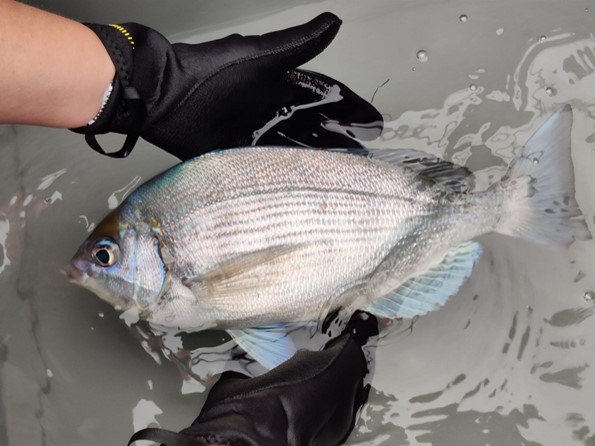
Fish INTEL: February 2023 update
For the first update of 2023, we've continued to track species such as tuna and sea bass in UK waters. We've also started suggesting management adaptations based on the data we've gathered so far - a big step for the project.
Ecology and tagging - what are we starting to discover?

Bluefin tuna in UK waters
Credit: Tom Horton, University of Exeter
UK
3 tuna have reappeared from previous years’ tagging in the network.
We’ve also recorded several long-range movements of sea bass: Sussex to a Belgian array (with one return to Sussex again), and movement from Sussex to Plymouth has been detected from another of our tagged fish.
Plymouth University has secured two more years of funding to keep maintaining the receivers that listen out for the fish. Additional receivers will be placed in the Solent, Isle of Wight and off Poole.
There are also plans to keep and maintain the Isles of Scilly network of receivers, and possibly even add to this. It has been a particularly interesting array, as it has led to a greater knowledge of crawfish (spiny lobster) movement, but acted as a bonus for bluefin, as they were recorded in this area for a longer period in 2022 – something that wasn’t expected.
France
Producing habitat maps for species in project locations
Habitat maps have been produced for each pilot site. This will help understand how current spatial management measures, such as existing MPAs, can be used to identify important locations for fish, and potential for management. It may be that fisheries regulators at local level see Fish INTEL evidence to support adding fish as features for protection in some MPAs, or indeed develop new spatial regulations to control fishing (seasonally or permanently) in some areas, to support more sustainable fishing in larger outside locations.
Communicating results with stakeholders
Meetings have been taking place in Brittany, France, to share the project and initial results with Brittany fishers. Meetings are to be held in February with Normandy fishers, and in late February with Sussex fishers. This is an important stage of the project, as we are beginning to suggest and receive ideas for management adaptations for the species based on the migratory behaviour science discovered with our tracking work.
Our presentation highlighted the current legal clauses and campaigning that can be used to support better protection of anadromous fish (species that can move between freshwater and marine salt water).
A web-atlas has been developed that will allow stakeholders to see how our fish have moved, and how this relates to fish habitat. The mapping products will be ready in February.
Communication
A new newsletter has been published by our French partners.
The FISH INTEL project film on YouTube has so far received over 400 views since it was uploaded in December 2022. If you haven't seen it yet, we highly recommend giving it a watch.
The conclusion of the FISH INTEL project that we had been a part of took place on March 2nd 2023.




